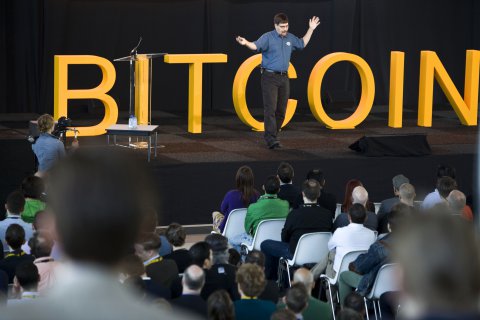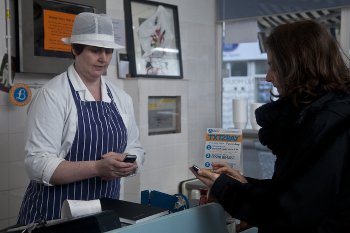 I spent a few months this year working with the Social Trade Organization (STRO) based in Utrecht, The Netherlands, an innovator in the field of complementary and digital currencies. STRO was launching a new platform for its digital payment system and starting a large, EU funded project with partners in Bristol, Sardinia and Barcelona. I wanted to know these projects and to better understand STRO’s methodologies and technology for creating regional C3s – commercial credit circuits. Also, a big bitcoin conference was to take place in Amsterdam in May and I wanted to go to that to extend my knowledge of digital decentralized currencies.
I spent a few months this year working with the Social Trade Organization (STRO) based in Utrecht, The Netherlands, an innovator in the field of complementary and digital currencies. STRO was launching a new platform for its digital payment system and starting a large, EU funded project with partners in Bristol, Sardinia and Barcelona. I wanted to know these projects and to better understand STRO’s methodologies and technology for creating regional C3s – commercial credit circuits. Also, a big bitcoin conference was to take place in Amsterdam in May and I wanted to go to that to extend my knowledge of digital decentralized currencies.
Bitcoin has captured the imagination of millions around the world and kicked off what could be a revolution in money. Before bitcoin, however, or even digital currencies, there was, and is, a movement in “complementary currencies”. Complementary currencies complement national currencies. Indeed, they are typically local or regional sub-national exchange systems or markets using vouchers as medium of exchange initiated by groups of people. Bitcoin and other crypocurrencies are typically private, digital assets traded globally accepted by handfuls of businesses for payment. Are complementary currencies and digital assets viable tools for sustainable economies and the social economy?
 The Bitcoin Foundation conference was quite impressive featuring three dozen booths of various businesses busy in the ‘bitcoin ecosystem’ with 1100 attendees and participants from around the world, a bevy of legal experts on the subject and practitioners and ‘ambassadors’ from several continents. Investors at a panel on investment revealed that between the three of them would invest over $100 million in bitcoin itself and in the businesses around it over the coming two years. That’s a lot of faith and will at work in the ‘bitcoin space’. What’s at stake? Why the enthusiasm?
The Bitcoin Foundation conference was quite impressive featuring three dozen booths of various businesses busy in the ‘bitcoin ecosystem’ with 1100 attendees and participants from around the world, a bevy of legal experts on the subject and practitioners and ‘ambassadors’ from several continents. Investors at a panel on investment revealed that between the three of them would invest over $100 million in bitcoin itself and in the businesses around it over the coming two years. That’s a lot of faith and will at work in the ‘bitcoin space’. What’s at stake? Why the enthusiasm?
I could understand the enthusiasm. I had been equally giddy at the idea that any group of people could create their own money. My interest, a near obsession, began some years ago and I found kindred spirits in the complementary currency movement. A movement? At least an international network of practitioners and researchers involved in their respective communities and countries sharing resources and supporting each other. Central to the complementary currency crowd was an understanding that the complementary currency is a means by which to empower communities to realize sustainable development in the locality or region. There is a stream within the complementary currency milieu that sees “social money” as a tool of the social economy.
There have been hundreds if not thousands of groups that have used monetary-type tools in their communities, many that have come and gone. There are also dozens of private or commercial business-to-business barter systems that tend to be larger and more sustained. It turns out it’s not that easy to make local currencies operat7 to use as a medium of exchange though accepted by handfuls of businesses as money. It’s highly liquid and has become a speculator’s sport. I am still astounded at how a new currency with uniquely digital features can be conjured up out of thin air and attract millions of dollars and followers to it.
At one booth I found out that there are about 350 cryptocurrencies in existence of which bitcoin was the biggest. This particular business offered mining services in these various cryptocurrencies. So you pay Canadian dollars or other national currency in order to be able to earn cryptocurrency as a miner. Other fascinating businesses included exchange interfaces for trading in cryptocurrencies, ATMs for bitcoins, security service for bitcoin wallets and bitcoin transmission services. If money is not neutral, as I heard at the bitcoin conference and as I have heard at complementary currency conferences, neither are the people who are attracted to them. I found a couple of community-oriented people but by and large it seemed this was a libertarian crowd. Some people I chatted with at the conference were excited about getting away from governments and from having to pay taxes. They were also excited about not paying exorbitant fees for transactions charged by credit card companies and money transmitters – ok, that I got. Others saw a potential for financial inclusion and for lifting people out of poverty. I thought that was a lot of hope for what is at the moment an asset that must be bought and sold with national currency (for most ordinary people anyways), whose value is volatile and based only on demand for it. But who knows if things keep developing. Meanwhile, I’ll keep my feet relatively on the ground and work within the complementary currency field.
The Social Trade Organization where I worked for several months is a trail blazer in the complementary currency field. STRO has been working 20 years in the field of monetary type tools for sustainable community-based development and economies. Many of their projects have been in Latin America – they have offices in Uruguay and Brazil – and are considered part of a solidarity or social economy as well as the wider economy. Their commitment includes developing a banking quality payment system software, Cyclos that any group can license at low cost or use a community version for free. STRO won the E-pay Innovation Award supported by the Bill and Melinda Gates Foundation at the Electronic Transactions Association conference in April for Cyclos. Cyclos is used by over a hundred groups around the world ranging from small local groups to commercial businesses.
Bristol Pound using Cyclos platform
With Europe in the throes of a prolonged recession, a number of communities are using Cyclos to run local barter exchanges. A local group of residents in Volos, Greece received media attention when they launched their exchange a few years ago running the administration of their system using Cyclos. The small business members of Sardex in Sardinia do over a million euro a month in trade with each other using Cyclos. STRO is leading a multi-partner EU funded project with Sardex in Sardinia, partners in Barcelona and in Bristol the municipality and the group who run Bristol Pound to scale up their technology and methodologies in the EU. This project, Digipay4Growth, will establish new credit instruments and technology for regional development that will support local businesses and economies.
Whether it’s cryptocurrency you favour or creating a local exchange, there’s no quick fix in sight. It takes a lot of work to create effective local currencies and exchanges and to use digital non-national currencies for financial inclusion or poverty reduction. So far, these exchanges and digital currencies offer some good but limited support for sustainable local economies. The world’s economies are at the beginnings of a digital currency phenomenon. We are still understanding how to make these tools of the social economy.
Additional Resources
- No Small Change: Evaluating the Success of your Community Currency Project – New Economics Foundation
-
Social Trade Organization
-
Cyclos
-
Create your own community using Cylos
-
International Journal of Complementary Currency Research – see my paper “A two-marketplace and two-currency system: A view on business-to-business barter exchange“ and other papers
-
Currency Solutions for a Wiser World – Bernard Lietaer
http://www.lietaer.com/
Melina Young is a practitioner in regional exchange systems and a Senior Researcher with the Social Trade Organization. She has extensive experience working with diverse communities. She holds an MSc in European Political Economy from the London School of Economics, certificates in Community Economic Development from Concordia University and Simon Fraser University and a Bachelors in Commerce from the University of Ottawa.







